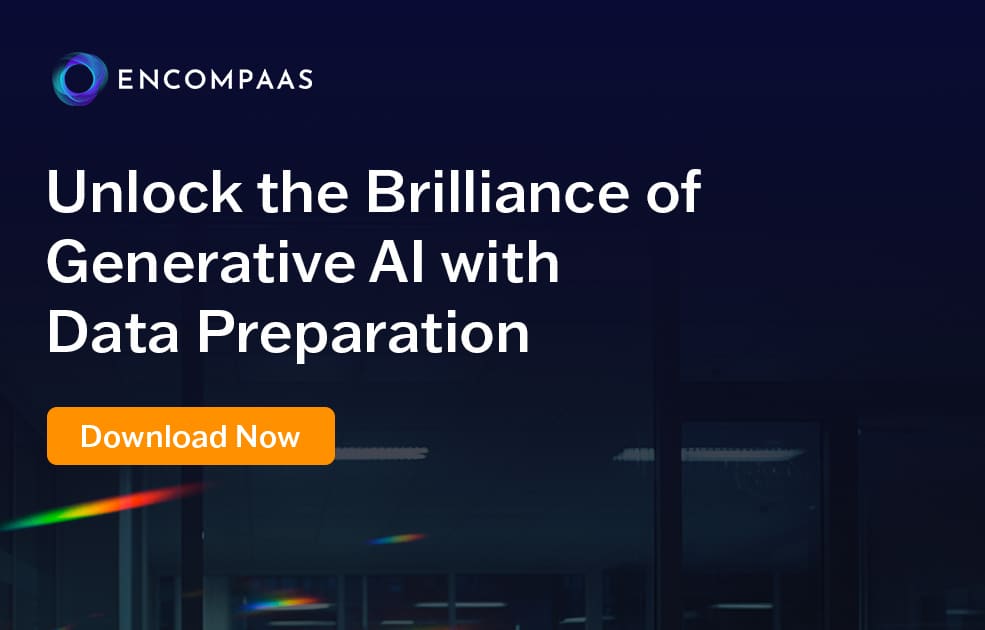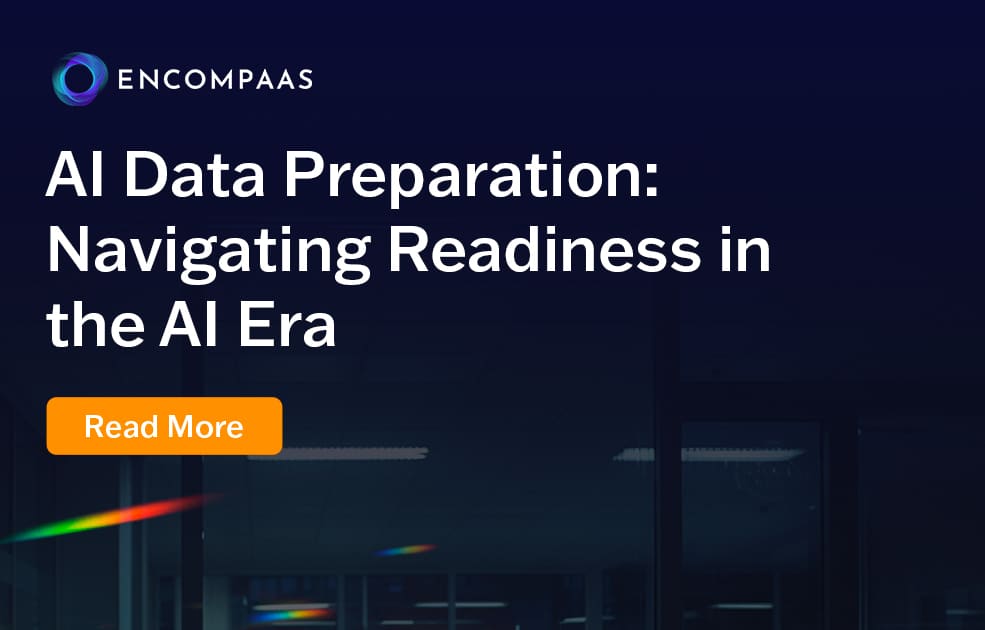Data governance strategy: Seven steps to an effective strategy
Authored by EncompaaS - Aug 18, 2023

In today’s digital age, data is so much more than a trendy term; it’s an invaluable resource. As the volume and complexity of data grow, it’s becoming a major challenge for modern businesses to manage their data lineage effectively.
Having a solid data governance program is no longer just an option; it’s critical. This article serves as a practical guide in seven actionable steps to help your organization implement successful data governance.
Main takeaways from this article:
- Having effective data governance processes in place is essential for managing the increasing complexity and volume of data in modern organizations.
- Clear goals and objectives are crucial in designing a data governance strategy that aligns with the overall business strategy.
- Assessing the current data management practices can help identify the gaps and provide opportunities for improvement.
- Investing in the right data governance tools and technologies can enhance data governance efforts and facilitate compliance and security measures.
- The role of data stewards in the successful implementation and monitoring of the data governance strategy cannot be overemphasized.
- Continuous monitoring, measurement, and refinement of the data governance strategy are crucial for its ongoing success and effectiveness.
What is a data governance strategy?
A data governance strategy is a comprehensive plan that outlines how an organization collects, manages, protects, and utilizes its data assets. It involves implementing processes, policies, and technologies to ensure data accuracy, consistency, and security, while also aligning with the organization’s objectives.
The need for a robust data governance strategy
Let’s understand why the need for a robust data governance initiative is greater than ever in 2024.
It’s challenging without effective data governance
It’s a steep, uphill battle for organizations that lack an effective data governance strategy. The challenges they face can seem insurmountable. With the exponentially increasing volumes and complexity of data catalog, managing, protecting, and maximizing data’s value becomes an exceedingly difficult task.
Being submerged in a sea of unsorted, chaotic data can hinder the decision-making process, obscuring insights that could drive growth and efficiency.
The tangle of regulatory compliance
On the flip side of this challenge is regulatory compliance. Navigating the intricate labyrinth of data regulations without a robust data governance strategy is no small feat. Failing to comply with these regulations, such as GDPR or CCPA, can result in hefty fines, not to mention the potentially irreversible damage to your organization’s reputation.
Compromised data quality
Another major challenge organizations face in the absence of a strong data strategy is compromised data quality. Without clear standards and practices, inaccuracies and inconsistencies can easily permeate data, causing a string of poor business decisions, missed opportunities, and compromised customer experiences.
Risk of data security breaches
Underestimating the importance of a successful data governance strategy might also leave your organization vulnerable to data breaches. In the absence of a thorough and effective data governance strategy, securing critical data from cyber threats becomes an uphill task.
Cyber threats can not only cause catastrophic loss of sensitive data but also damage your organization’s credibility.
Poor business performance
Ultimately, failing to harness and manage data effectively through rigorous data governance can become a silent killer of business performance. Poor data governance often leads to wasted resources, less informed decision-making, reduced competitiveness, and diminished customer satisfaction.
These real-world consequences highlight the urgent need for a robust data governance strategy in today’s data-driven world.
How to build an effective data governance strategy
To create an impactful data governance strategy, one must navigate through the following seven critical steps. These stages are designed to guide data governance professionals in establishing, executing, and refining a practical framework.
Step 1: Establish clear goals and objectives
The first essential step to devising an efficient data governance strategy is to set clear, unambiguous goals and objectives. Before you jump in, it’s imperative to answer questions like:
- What do you hope to achieve with your data governance strategy?
- How does it align with your broader business objectives?
Every company has distinctive needs. Therefore, the aims you set should reflect your company’s individuality. This could mean focusing on areas like:
- Increasing data accuracy
- Assuring compliance with regulations
- Promoting data transparency
- Improving data security and privacy
Once you have a firm grasp on what you want to accomplish, make sure to document these goals. This will not only guide your strategy but also help measure progress and success further down the line.
It also creates a shared understanding within the organization about what the data governance strategy aims to achieve. This clarity is invaluable as it lays the groundwork for all your future data governance efforts.
Step 2: Assess current data management practices
Begin your journey to a robust data governance strategy by starting at home – take a good, hard look at your current data management practices. This self-assessment is no place for pride or ego; be brutally honest.
Here’s how you can do it:
- Outline your current data lifecycle: Start by tracing your data from its inception, through its use, and finally to its disposal. Understand how and where your data is created, stored, accessed, and deleted.
- Assess the integrity of your data: Are there persistent errors or gaps in your data? Irregularities could indicate deeper systematic issues.
- Analyze your data accessibility: Consider who has access to your data, how they can access it, and what checks and controls are in place. This includes both physical access to servers and digital access via software and networks.
- Examine your current data protection measures: Look into the robustness of your security systems and policies. Are they sufficient to prevent unauthorized data access or loss?
- Consider your current data governance team: Review the roles, responsibilities, and capabilities of your current data governance team. Are they properly equipped to handle your data management needs?
Identifying strengths and weaknesses in your present practices helps lay the groundwork for the succeeding steps in building your data governance strategy.
Step 3: Develop a data governance framework
The creation of a well-defined data governance framework is paramount to your organization’s ability to manage data effectively and intelligently. It comprises policies, standards, and roles designed to guide data usage and ensure quality and consistency across all organizational levels.
Here’s how to go about it:
- Define policies: Draft clear and concise policies on data access, usage, and management. This will establish standards on how data is to be treated and manipulated within your organization.
- Set standards: Establishing standards forms an integral part of the data governance framework. With data becoming increasingly complex, these standards will provide an operational guide for managing the volume, variety, velocity, and veracity of data.
- Identify roles and responsibilities: Identify key data governance roles, such as data owners, data stewards, and data custodians. Establish their responsibilities to ensure accountability, resolution of data issues, and alignment with the data governance strategy.
- Design processes: Develop and document repeatable processes for data governance tasks. This will ensure alignment and consistency in data actions across the organization.
Step 4: Implement data stewardship
Data Stewards play a crucial part in managing your organization’s data resources accurately and ethically. They are responsible for ensuring that your data is clean, consistent, and ready to be used.
- Define the roles: First, specify who your data stewards are – identify employees who understand the significance of data quality and integrity. They may include business analysts, managers, IT staff, or any other suitable roles within the organization.
- Educate and empower: Once identified, educate them about their responsibilities and empower them to fulfill their duties effectively. This equates to providing the necessary access, tools, resources, and training to fulfill their roles.
- Establish guidelines: To facilitate their tasks, establish clear data stewardship policies and practices. Create a guideline that covers data quality, metadata management, data privacy, and data lifecycle management, amongst other key areas.
- Formalize their role: It’s not just about assigning the responsibility; it’s about formalizing the role within the organization. Establish a clear mandate that covers their responsibility to ensure they have the authority to govern the data effectively.
Data stewardship is the adhesive that binds your entire data governance framework. Implementing effective stewardship is about finding the right individuals, equipping them adequately, and instilling a sense of organizational importance in their roles.
Step 5: Invest in the right tools and technologies
The success of your data governance strategy largely depends on the tools and technologies you choose to employ. It’s not just about investing in cutting-edge solutions; what truly makes a difference is selecting the right tools that align with your specific data governance needs.
Moreover, these tools must advance your overall business strategy, not just solve isolated data issues.
Here’s why you need the right tools and technologies.
- Comprehensive data management solutions: This includes databases, data integration platforms, and data quality tools. These tools allow you to collect, clean, integrate, and manage data from a variety of sources.
- Business intelligence and analytics: It’s crucial to turn your data into actionable insights. Tools equipped with powerful analytics capabilities help you visualize patterns and trends in your data, enabling better decision-making.
- Data governance platforms: Platforms such as EncompaaS provide a single hub for data governance, offering tools to manage data quality, enforce policies, and automate workflows. This not only streamlines the data governance process but also ensures compliance at every step.
- Security and compliance tools: It is essential that your data remains secure and adheres to various regulatory standards. Tools specializing in data security and compliance can help protect your data from breaches and regulate access control.
Step 6: Ensure compliance and security
Paying heed to compliance and security is a pivotal element of any data governance strategy. Here’s what you need to consider:
- Understand regulatory requirements: Depending on your industry and marketplace, your organization might need to adhere to various regulations. These could range from HIPAA for healthcare to GDPR for businesses dealing with European consumers. Ensure you comprehend these regulations and integrate their requirements into your data governance strategy.
- Control access: Stringently monitor who can view and modify your data. Implement secure authentication protocols and delegate access based on roles and responsibilities. This segregation of duties helps prevent unauthorized access and data breaches.
- Data classification: Classify your data based on sensitivity levels. This allows you to apply the necessary security measures to each data category, guaranteeing essential information gets the highest protection.
- Audit trails: Maintain logs of how, when, and by whom data is accessed or edited. Well-preserved audit trails help resolve discrepancies and investigate potential breaches, ensuring better accountability.
- Partner with technology: Leverage tools like EncompaaS that can help automate compliance checks and maximize data security, diluting human-induced errors and enhancing efficiency.
Remember, compliance and security shouldn’t merely be afterthoughts—embed them at the core of your data governance strategy for fortified organizational resilience.
Step 7: Monitor, measure, and refine
Nailing down a data governance strategy isn’t a set-and-forget deal. Your strategy will require regular scrutiny and adjustments to ensure it continues to drive business value.
Think of it as a journey where being adaptable and able to refine your strategic approach will keep you on course.
Here are some pointers to help you streamline the process:
- Monitor: Consistently keep an eye on your data governance practices. This includes staying alert to any changes in data usage patterns, issues cropping up, or new regulations that may demand amendments in your strategy.
- Measure: Leveraging quantifiable metrics is paramount. Track KPIs (Key Performance Indicators) pertinent to data quality, compliance adherence, user engagement, and more to evaluate the effectiveness of your strategy.
- Refine: Make data-driven decisions and iteratively refine your strategy. Use analytics and feedback to guide these refinements. You may need to update roles, tweak your policies, or even revise overall objectives based on the insights derived.
Enhance your data governance strategy with EncompaaS
If you’re ready to take your data governance initiatives to new heights, EncompaaS is the tool for you. This platform is fundamentally grounded in the understanding of the importance of comprehensive and strategic data governance for business success.
EncompaaS seamlessly integrates into each step of your data governance strategy, elevating effectiveness. From compliance management to data quality monitoring, the platform’s range of features makes it an indispensable asset.
Automated policy enforcement is another notable feature, reinforcing consistency, reducing manual errors, and enhancing efficiency.
Are you excited to take that step toward transforming your data governance? We invite you to learn more about EncompaaS and the significant difference it can make in your organization.
To get a firsthand experience of its capabilities, why not book a demo today?
Book a demo
Let's get started
Experience the Power of EncompaaS!
Submit this form to see EncompaaS in action with a demo from our information management experts.
Request a demo today
Related Resources

- video
Understand Your Data & Harness Generative AI
Jesse Todd (CEO, EncompaaS) and Jaimie Tilbrook (CPO, EncompaaS) delve into the critical challenges companies face in managing their vast data landscapes, emphasizing the importance of understanding what data is, where it is located, its context, and its value.
Learn More




